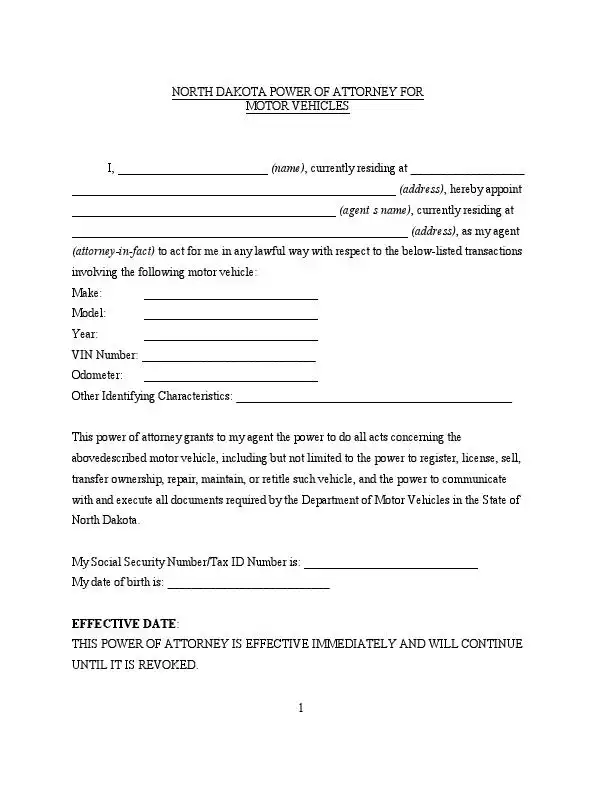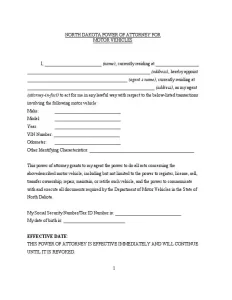North Dakota Motor Vehicle Power of Attorney Form
The North Dakota vehicle power of attorney is a legal document allowing a car owner to authorize another person to handle matters related to their motor vehicle. This could include registering, buying, selling, or making claims for the car. Like in other states, this type of power of attorney is specifically tailored to motor vehicle transactions in North Dakota.

Build Your Document
Answer a few simple questions to make your document in minutes
Save and Print
Save progress and finish on any device, download and print anytime
Sign and Use
Your valid, lawyer-approved document is ready
Important aspects of the vehicle power of attorney in North Dakota include:
- Execution requirements. The vehicle owner must sign this document. Notarization is advisable for verifying signatures on the North Dakota POA forms.
- Specificity of authority. The document should clearly outline the specific powers granted to the agent, such as applying for a title, registering the vehicle, or completing a sale.
- Duration. The duration of the power can be stipulated in the document, or it will be governed by general state laws regarding the termination of powers of attorney.
In North Dakota, the law governing the continuation of a power of attorney after the principal’s death is outlined in NDCC 30.1-30-04 (5-504). This section of the North Dakota Century Code states that a power of attorney is not automatically revoked upon the principal’s death until the agent receives actual notice of the death.
North Dakota Vehicle Power of Attorney Form Details
| Document Name | North Dakota Motor Vehicle Power of Attorney Form |
| State Form Name | None |
| Relevant Link | North Dakota Department of Transportation |
| Avg. Time to Fill Out | 15 minutes |
| # of Fillable Fields | 25 |
| Available Formats | Adobe PDF |
Filling Out North Dakota Vehicle POA
These steps ensure that your North Dakota motor vehicle power of attorney is correctly completed and legally compliant.
1. Fill in Your Personal Information
Begin by entering your full legal name where it says “I, (name),” followed by your current residential address in the provided space. This field confirms your identity as the principal granting the power.
2. Appoint Your Agent
Specify the name of the person you designate as your agent in the space provided. Include their full legal name and residential address. This individual will have the authority to handle your vehicle-related matters.
3. Describe the Vehicle
Provide detailed information about the vehicle that the power of attorney will cover, such as the make and model of the car, year of manufacture, VIN number, and odometer reading. If there are any unique features or identifiers for the vehicle, list them here.
4. Include Your Social Security Number and Date of Birth
Enter your Social Security Number or Tax ID Number and your date of birth in the respective fields. This information helps further establish your identity for record-keeping and legal purposes.
5. Specify the Effective Date
Determine when a power of attorney will become effective. Typically, it is effective immediately upon signing unless specified otherwise. Note that this document will continue to be effective until you revoke it.
6. Appoint a Successor Attorney-in-Fact
If you wish to appoint a successor attorney-in-fact, provide the name and address of this individual in the designated areas. This person will take over responsibilities if your primary agent is unable or unwilling to serve.
7. Sign and Date the Document
On the line provided, sign and print your name below your signature. Fill in the date you are executing the document, ensuring accuracy, as this indicates the formal activation of the document’s terms.
8. Notarization
The document must be notarized to be legally binding. Take the document to a notary public. The notary will verify your identity and witness your signature before affixing the seal and signing the acknowledgment section.
9. Distribute Copies
Provide a copy of the notarized document to your agent and keep the original in a safe place. You may also want to give copies to relevant third parties, such as the Department of Motor Vehicles or a vehicle dealership involved in a transaction.
